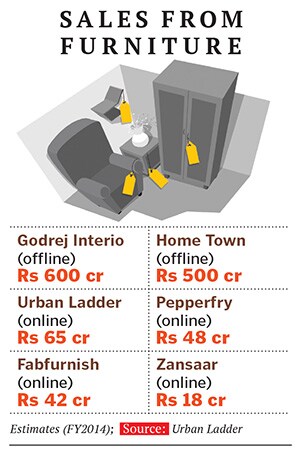How Urban Ladder climbed atop the furniture business
By scaling down before they scaled up, the two-year-old Urban Ladder has climbed to the top of India's online furniture retail market


Ashish Goel and Rajiv Srivatsa (both 35), who launched Bangalore-based Urban Ladder are almost apologetic about calling themselves the leaders in India’s online furniture market. For one, their company is ahead of their nearest rivals by only 10 to 15 percent by revenue. Second, they see plenty of opportunity for themselves and their competition, as more of India’s $15 billion (estimate by online furniture retailers), largely unorganised furniture market moves online.
Online furniture retailers in India were proliferating when Urban Ladder launched in July 2012. After the initial months, it launched a pan-India operation to compete with players such as Pepperfry (set up in January 2012), FabFurnish (March 2012) and HouseFull (August 2006). Soon enough, Goel and Srivatsa realised that although Pepperfry and FabFurnish were not much older than Urban Ladder they had far higher revenues.
Urban Ladder had solid designs and a growing market, but customers complained of damaged products, delayed delivery and poor customer service. Poor infrastructure meant delivering and servicing items such as sofas and desks from its sourcing hub in Jodhpur, Rajasthan, was difficult for a small team.
Instead of trying to catch up with its competitors, the team scaled down and focussed on three cities—Mumbai, Delhi and Bangalore—for 12 months. Marketing was also limited to targeted bursts on Facebook, rather than more expansive Google ad spends. While competitors offered wide product ranges, particularly in home décor, Urban Ladder stuck to a smaller offering and kept inventory light, using buying behaviour data to determine stock keeping units (SKU) and cross-promote products.
For instance, the tech team headed by COO Srivatsa—an IIT-Madras alumni who had worked with Infosys, Cognizant and Yahoo—uses analytics to understand which bedside tables sell better with which beds, and then employs targeted advertising.
CEO Goel, an IIT-Bombay alumni who has worked with McKinsey, works on the goods. He helped figure out, for example, how to improve packaging so that desk corners aren’t damaged during transportation. Not only are products packed with at least five layers of foam sheets, there are special packaging teams in all its 10 warehouses.
Urban Ladder raised $1 million from Kalaari Capital in August 2012 and $5 million from SAIF Partners and Kalaari Capital in November 2013. In July 2014, it raised $21 million from Steadview Capital.
Deepak Gaur, MD, SAIF Partners, says, “A strong focus provided initial momentum and a loyal customer base. The company has continued to scale up with a cautious, efficient use of capital.”
Gaur has been impressed with the pair’s attention to customer feedback. Urban Ladder delivers products themselves—they are now present in 11 cities—and makes it a point not to use third party logistics, because they feel this damages customer service, says Goel.
The startup claims it delivers 125 orders a day, with an average ticket size of Rs 20,000. This would add up to about Rs 90 crore for the year, although they did not disclose exact revenues. An investment banker who tracks the sector confirmed the company is a market leader. Its attractiveness to investors stems from its decision to not diversify (unlike Pepperfry, which also retails home decor) which means their margins are also higher, says the banker.But how good are the products? There is no quantitative measure, other than the company’s success. FabFurnish, for instance, talks about mirroring the Ikea model of DIY furniture and flat-pack design. However, at Urban Ladder, Goel says the emphasis on design is more than marketing spiel. “All of us in urban India are living in smaller spaces,” he says. “We need multipurpose furniture.” One of their best-selling products is the Hamilton Nested Stool, a set of three stools that fit one beneath the other. “Family structures are changing. Grandparents are visiting but not staying the whole time. So we’re seeing demand for smaller shelving units in the guest room,” Goel says.
Srivatsa uses data to understand city-specific product demand and tailor marketing spends accordingly.
Attention to designs that are multi-functional and cater to the demands of new-age urban homes is what differentiates Urban Ladder’s products.
While the duo points out that taking on the unorganised, brick-and-mortar furniture market is the main focus, keeping up with online competition will be a challenge. In May 2014, Pepperfry raised $15 million from Bertelsmann India Investments and Norwest Venture Partners. Meanwhile, Rocket Internet-backed FabFurnish aims to end the year with Rs 200 crore in revenue. But Goel is not worried. “The three of us combined would still be less than Rs 500 crore, less than a percent of the total furniture market.”
They anticipate two major challenges ahead: One, cultivating a supply chain. Flipkart, Snapdeal and Amazon’s huge investments in bolstering logistics—the backbone of ecommerce—is testament to that. Two, recruiting design talent. Design, they point out, is a crucial differentiator and bringing quality designers to a startup isn’t easy.
Some business success stories are about a game-changing idea. Others are about cutting-edge technology. The Urban Ladder narrative is still developing. The company has taken a working model, bet on quality and focussed its efforts. Its success so far has ridden on its ability to deliver products and good services to particular cities, rather than try to meet demand from all corners of the country.
First Published: Aug 07, 2014, 06:02
Subscribe Now